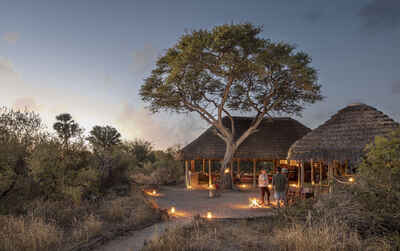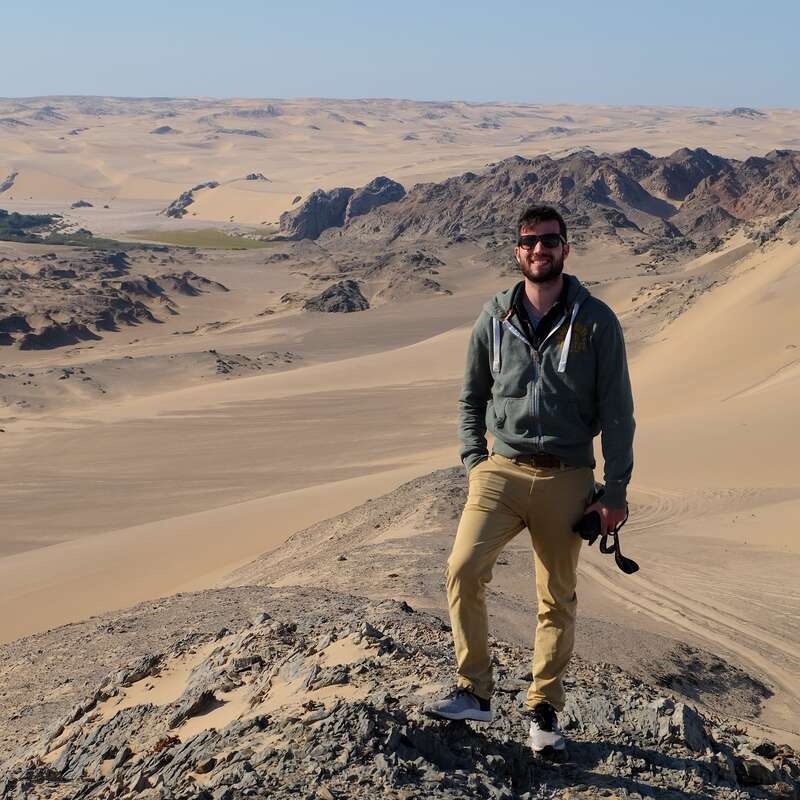About Camp Kalahari
From ostrich eggs to silver cups to oriental rugs, the décor at Camp Kalahari is decidedly eclectic.
And that’s in addition to the campaign furniture, old maps and pictures that adorn the main area.
Wander along the sandy pathway and take a look inside one of the big walk-in tents. Here you’ll discover four-poster canopy beds, their tall steel frames set on sisal matting, with dark-wood furniture and more of those oriental rugs.
The feel is cosy, enhanced by hot-water bottles in the winter months – but offset by a cooling fan when the temperatures rise. And while the en-suite bathrooms are effectively open air, they are thoughtfully protected by netting and fly sheets.
Spend your days here exploring the vast expanse of salt pans by quadbike or on horseback, or take to an open-sided 4WD vehicle for game drives, day and night: lucky guests may even spot an aardvark.
Bushman walks are a must for those interested in this ancient culture, while to visit a family of habituated meerkats is to marvel at their antics.
Returning to camp, how about a cool dip in the pool, or unwinding on a cosy sofa with a book? Then join your fellow guests at the long dining table and finish the day over a convivial meal while you chat over the day's adventures.
Our view
Camp Kalahari doesn't have the prestige or the refinements of its sister camps, but it offers a similar experience at a more economic price, and it's a bigger camp and an attractive option for travellers with children. The wide range of activities means that no one, young or old, should become bored. And while facilities and meals are less luxurious, the camp can deliver a relaxed and peaceful experience, with a great chance of seeing meerkats.
Accommodation
11 tents
Children
Best for 8+
Open
All year
Activities

4WD Safari

Birdwatching

Cultural excursion

Fly-camping

Guided walking safari

Night drive

Private activities

Quad-biking

Sleeping under the stars
Traveller reviews of Camp Kalahari
59 real, un-edited reviews from Expert Africa's travellers.
Arrived 28 Apr 2025, 3 nights
"Camp Kalahari review "A great experience""
Overall rating: Excellent
Arrived 14 Jun 2024, 3 nights
"Lots of unique experiences"
Overall rating: Excellent
Arrived 3 Jun 2024, 3 nights
"Camp Kalahari review"
Overall rating: Excellent
Arrived 25 Sep 2023, 3 nights
"Camp Kalahari - unique experiences"
Overall rating: Excellent
Arrived 4 Oct 2022, 3 nights
"Camp Kalahari review"
Overall rating: Excellent
Arrived 2 Aug 2022, 3 nights
"Camp Kalahari review"
Overall rating: Excellent
Arrived 2 Aug 2022, 3 nights
"Camp Kalahari review"
Overall rating: Good
Arrived 9 Aug 2022, 3 nights
"Camp Kalahari review"
Overall rating: Excellent
Arrived 14 Jul 2022, 3 nights
"Camp Kalahari review"
Overall rating: Excellent
Arrived 27 Jul 2022, 2 nights
"Camp Kalahari review Good for meerkats"
Overall rating: Average
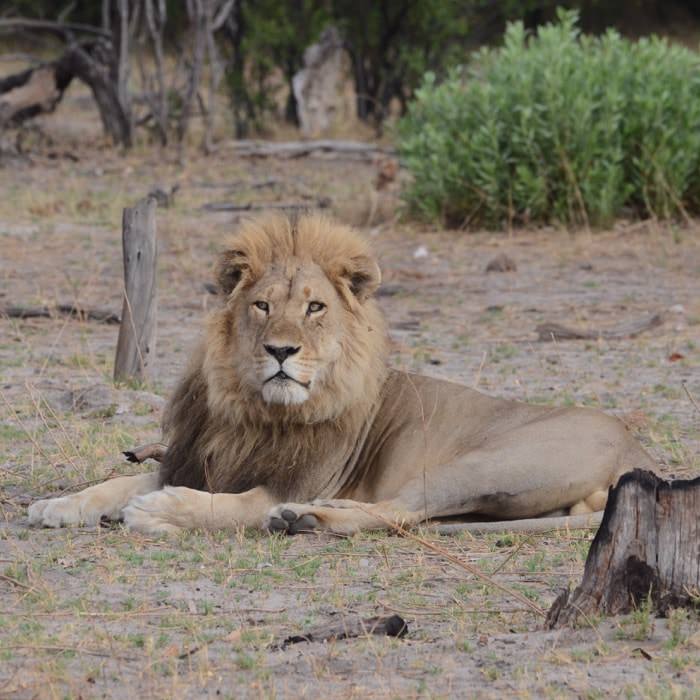
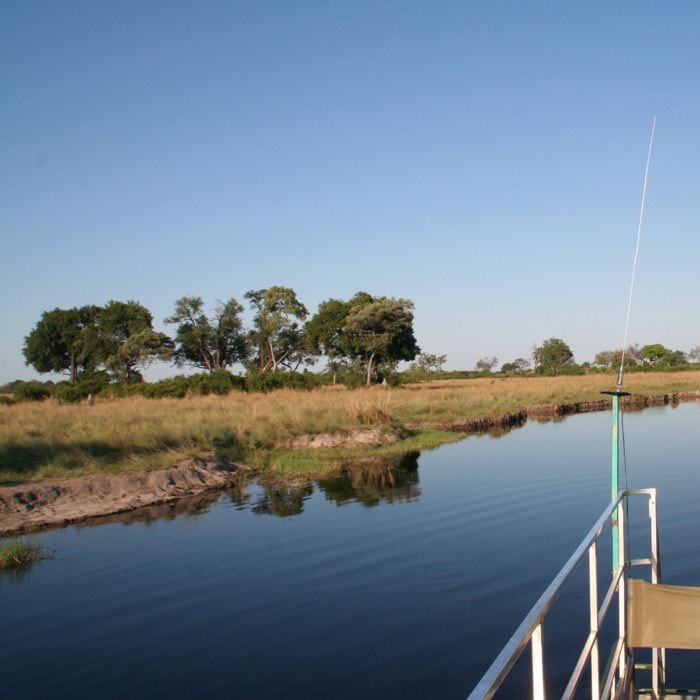
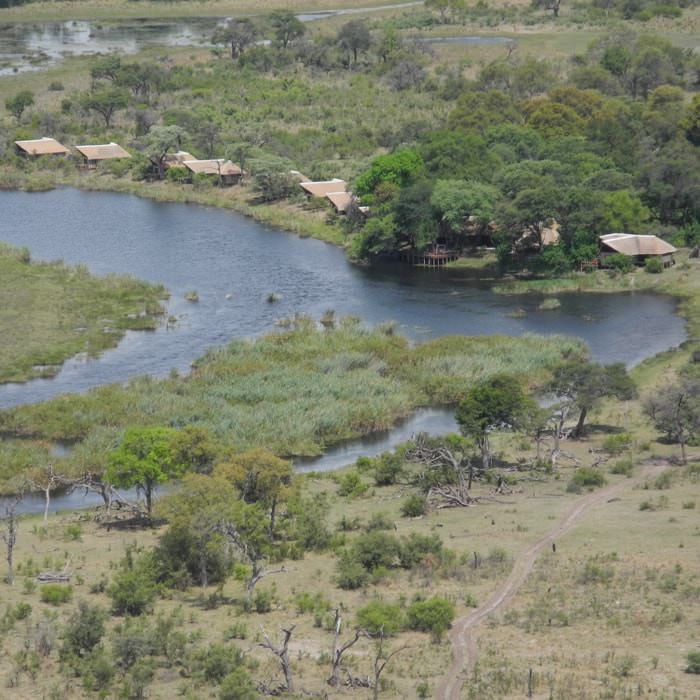
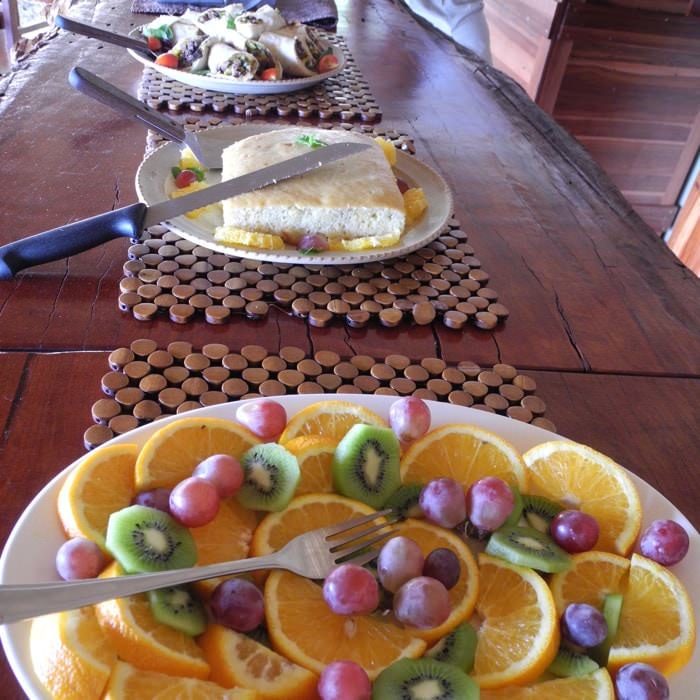
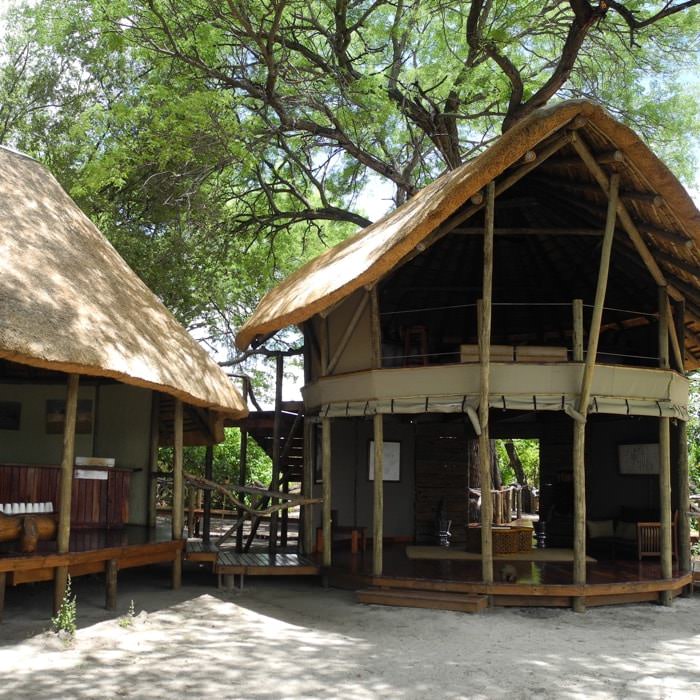
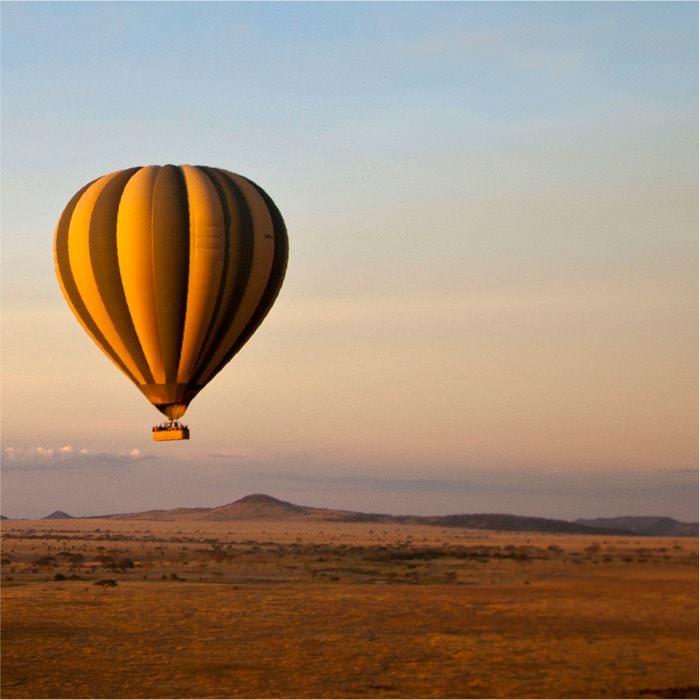
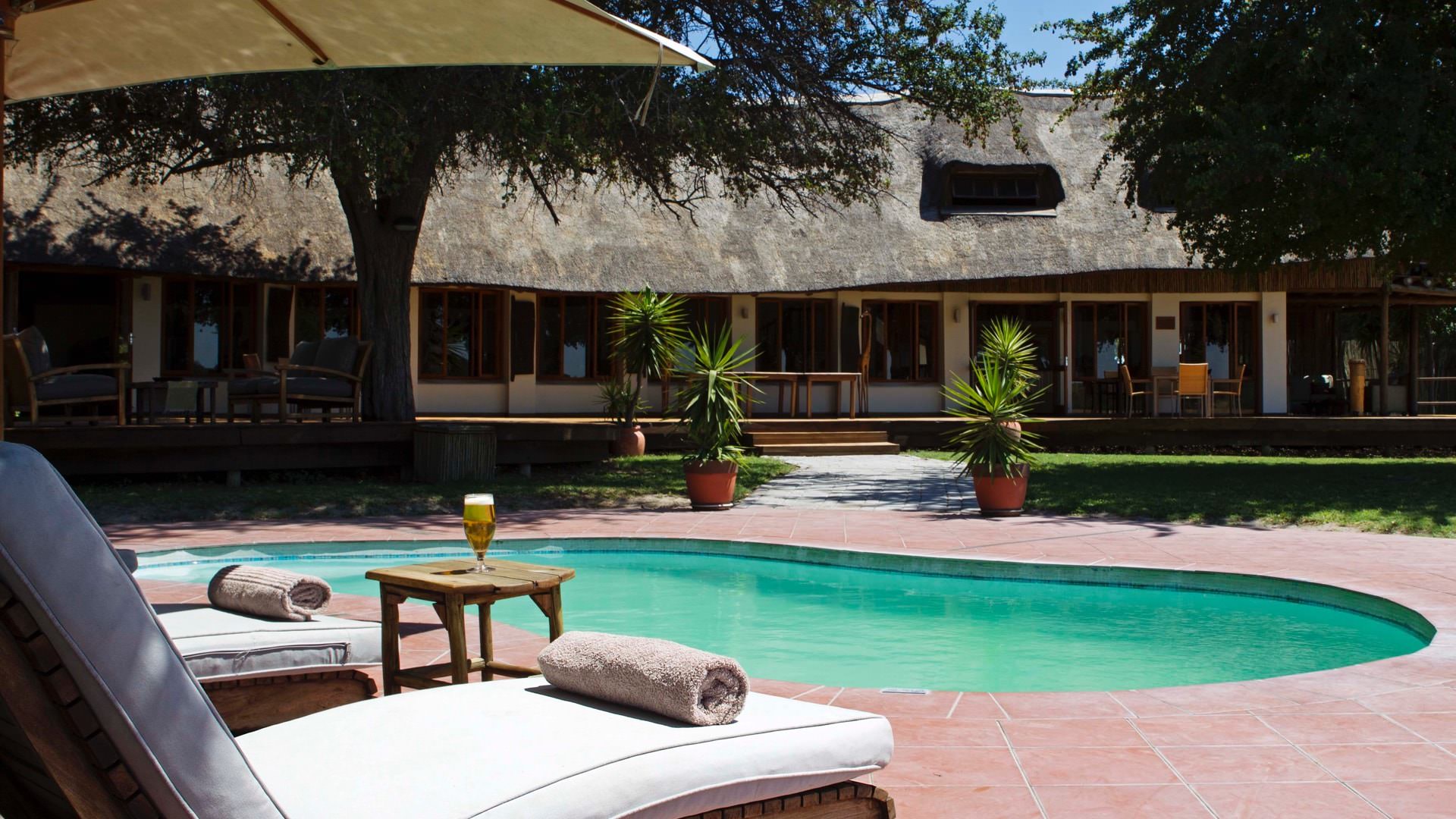
Expert Africa's gallery
When we travel we take lots of photos ourselves to give you a real and un-edited view of the safaris. See our 22 pictures of Camp Kalahari to get the candid view.
View gallerySafaris visiting Camp Kalahari
Just ideas, we'll always tailor-make a trip for you
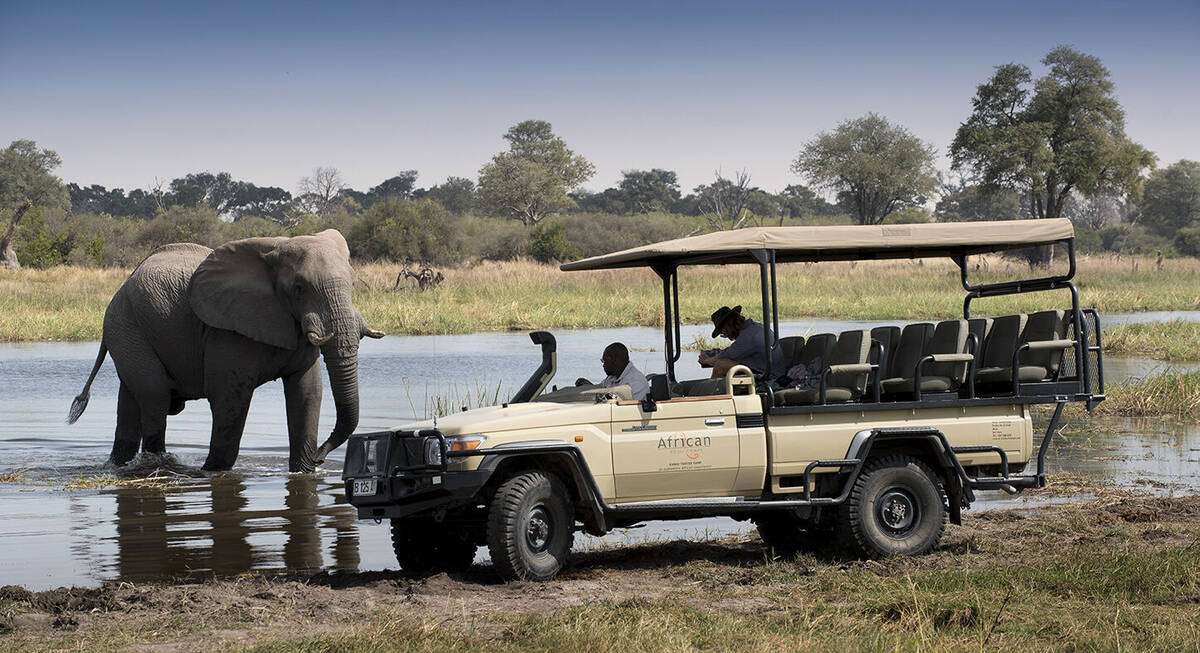
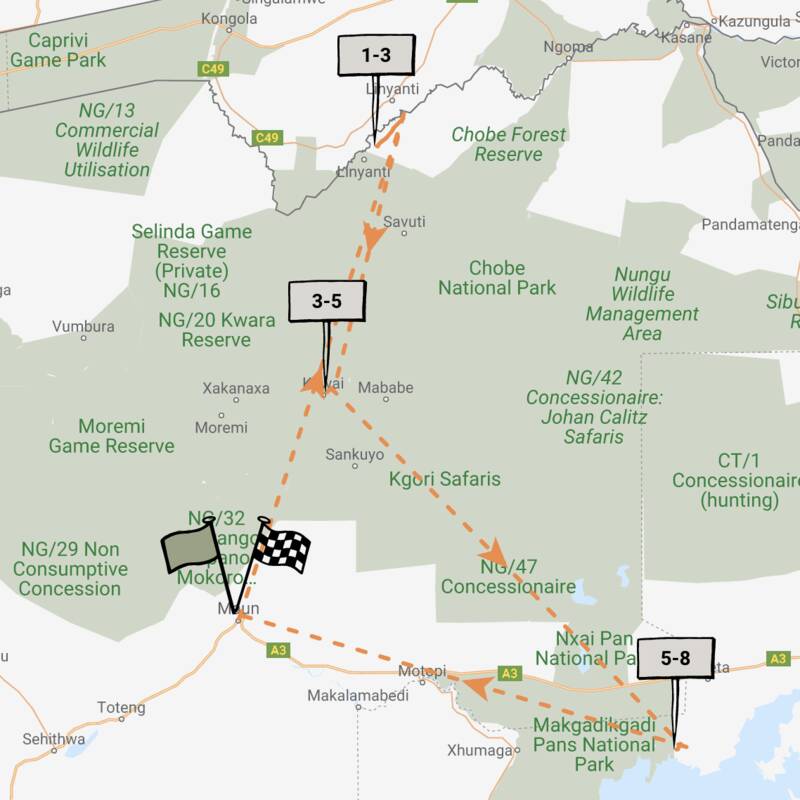
African Jacana Safari
7 days • 3 locations • 1 country
MAUN AIRPORT TO MAUN AIRPORT
An adventurous introduction to Botswana blending prolific wildlife, incredible landscapes and varied activities staying at relaxed camps in the Chobe Enclave, a community-owned reserve bordering the Moremi, and Makgadikgadi Pans.
Visiting Kalahari Salt Pans, Moremi & Surrounds and 1 other area
US$8,550 - US$12,280 per person
Camp Kalahari: Our full report
Camp Kalahari sits on the edge of Botswana's Makgadikgadi Pans on a shrubby outcrop known as Hyena Island.
A relatively simple camp, it makes a convenient and comfortable location from which to explore the salt pans in the dry season or to witness southern Africa's largest migration of zebra and wildebeest when the rains arrive.
Camp Kalahari is the simplest of three sister camps in the Makgadikgadi area, the others being Jack's Camp and San Camp. Their activities, however, are similar, so the choice of camp is largely a question of style and cost.
Sandy pathways lead to Camp Kalahari's 11 Meru-style canvas tents. Six of these are twin, four are double and one – designed with families in mind – is effectively one twin and one double tent linked by a large bathroom. The steel-framed, four-poster canopy beds in each tent are quite high off the ground, giving plenty of storage space for luggage underneath. For the summer months, there's a standing fan, while in the winter months, when evening temperatures really drop, we are pleased to say that a hot-water bottle is placed in each bed, ready for your return from dinner. Glasses and a flask of cold drinking water sit on an antique-style desk.
All of the tents are en suite, each bathroom – reached through the back of the tent – housing a toilet and shower. Although these bathrooms are effectively outside, they are screened by wooden palisades and most are covered by gauze netting and flysheets. The exception is the family tent, which has an open-top shower area.
The V-shaped, thatched main area at Camp Kalahari has two “arms” – one housing the dining room, the other the lounge. Both are on very slightly raised, polished concrete bases covered with sisal matting and oriental rugs. Like the rest of the camp, they are decorated with local crafts and furniture, as well as some campaign furniture, redolent of a bygone era of exploration. Old glass cabinets house artefacts (ostrich eggs, animal skulls, silver cups etc), and the walls are adorned with interesting old maps and pictures.
The dining room has one long table and directors' chairs for convivial mealtimes, a help-yourself bar and water cooler (both housed in old-style wooden chests), and a dark wooden sideboard with a permanent tea/coffee station. In the small lounge you'll find a couple of cosy seating areas where red/cream fabric covers the comfy sofas and cushions. A glass-fronted cabinet does service as a small curio shop and there is a multi-adaptor charging station for camera batteries etc.
On the outskirts of the camp, in the dappled shade of a camelthorn tree, is a swimming pool with a thatched, shady area covering a set of deck chairs and a couple of day beds. The location of the pool, away from the thicker foliage, provides a more open feel than the rest of the camp. Although the pool is not large enough to swim laps, it provided welcome relief from the December heat during our last stay in 2023.
Activities from Camp Kalahari and its sister camps are exceptionally varied and, unusually, are typically scheduled at the beginning of your stay. Among them are morning and evening 4WD safaris in and around the Makgadikgadi Pans National Park, often with spotlit night drives on the return to camp in the evenings. Night drives are also offered after dinner, particularly in the dry season (June–October), giving travellers the opportunity to spot nocturnal animals. We understand that it’s fairly common to spot aardvark here although we missed them on our last visit. During the rainy season night drives are only offered on request as the spotlight can attract a lot of insects. On 4WD activities open safari vehicles seat up to six travellers in three rows – giving each person a “window” seat.
A real highlight of both Camp Kalahari and its sister camps is a visit to one of the resident families of meerkat. These have been semi-habituated to humans: while they are wild animals, they more or less ignore visitors. Spending time following the meerkats as they foraged across the Kalahari for grubs, frogs and scorpions was a fascinating experience; they're exceptionally cute, very inquisitive and most will allow you to follow or sit with them at very close proximity. The meerkat family visit was amongst the wildlife highlights of our recent trip to Botswana.
Quadbiking excursions onto the huge Ntwetwe Pan (which covers about 6,500km²) are a real feature of visits to Camp Kalahari in the dry season, from around May to October. Because of the fragility of the pans, quadbiking is possible only during this period, sticking strictly to set tracks. (NB: It's essential that you read the quadbike warning in the 'Health & Safety' section below for our comments on bike helmets and insurance on this activity.)
Horseriding is also available here at additional cost, for both beginners and experienced riders. You can choose between rides of a few hours or – for experienced riders only – a multi-day trip of up to five nights.
The “Bushman experience” at Camp Kalahari is very good too – one of the best of the growing number of similar activities we have taken part in during our visits to Botswana. There's nothing fake about this experience; it's simply a group of men and women of varying ages sharing some of the knowledge passed down by their forefathers on how they have traditionally survived in this wild and harsh environment, and some of the games they have enjoyed, too.
Finally, there is a helicopter based at the nearby Jack's Camp. With space for up to three passengers at a time, the helicopter can be used for transfers (doors on) or scenic helicopter flights (doors off). Scenic flights can range from 15 minutes to much longer trips including visits to Kubu Island, Nata Bird Sanctuary and beyond, often including lunch or a champagne stop. However, please note that all helicopter flights are at an additional, substantial charge.
Sadly, the erstwhile visits to Chapman's Baobab are no longer. This ancient tree was estimated to be about 4,500 to 5,000 years old and in days past, a hole in the trunk was used as a postbox, where mail was left for collection by those passing by. Unfortunately the tree collapsed in January 2016, splitting the trunk, and has since rotted away.
Activities
4WD Safari
Birdwatching
Cultural excursion
Fly-camping
Guided walking safari
Night drive
Private activities
Quad-biking
Sleeping under the stars
Families & children
- Attitude towards children
- Camp Kalahari welcomes children of all ages. There is a family tent accommodating two adults and two children.
- Property’s age restrictions
- Children under the age of 12 years are not allowed to drive the quadbikes, but younger children may accompany an adult.
- Special activities & services
- None
- Equipment
- None
- Generally recommended for children
- Camp Kalahari caters well for slightly older children. It makes a fantastic family safari destination, and children love the meerkats. Unlike at Jack's and San camps, families with younger children are not required to take a private vehicle.
- Notes
- The salt pans are not home to prolific game, but lion, elephant and other dangerous animals (such as honey badgers) do sometimes pass through the camp, despite an electric fence. Children should always be closely supervised by a responsible adult.
Food & drink
- Usual board basis
- Full Board & Activities
- Food quality
- When we stayed at Camp Kalahari in December 2023, we enjoyed a range of excellent meals. We understand that with sufficient notice, the camp team can cater for most dietary requirements.
The camp bottles its own “Pillipilli-Hoho”, which is on hand at mealtimes. This blend of chillies, sherry and gin is very fiery but very tasty too. It's a great example of the little personal touches that make Camp Kalahari and its sister camps unique.
Breakfast is typically set out at 5.30am before the morning activity. A continental-style buffet of fruit, cereals, bread and yoghurts is complemented by cooked-to-order options, including eggs, bacon, tomato and toast.
Lunch is served shortly after returning to camp from the morning activity, usually around 11.00am. During our stay, we enjoyed an excellent and beautifully presented salad niçoise followed by a cheese platter.
After a siesta and before the afternoon activity, it’s time for high tea, though the precise timing will vary depending on the activity. We tucked into cucumber sandwiches, freshly made sausage rolls, carrot cake and sliced watermelon.
In the evening, dinner is usually served at around 8.00pm (though orders for main courses are usually taken at lunchtime). We started with green vegetable soup with a fresh bread roll, followed by a choice of lamb tagine with couscous, beef fillet with potato galette or a potato and halloumi bake. Our meal was rounded off with a sticky date pudding. - Dining style
- Group Meals
- Dining locations
- Indoor and Outdoor Dining
- Further dining info, including room service
- Private meals can be arranged on request.
- Drinks included
- There is a well-stocked bar from which all drinks – bottled water, soft drinks, local beers, spirits and a selection of (generally) South African wines – are included in the rates. Special or exotic drinks can be ordered in with advance notice, at additional cost.
Our travellers’ wildlife sightings from Camp Kalahari
Since mid-2018, many of our travellers who stayed at Camp Kalahari have kindly recorded their wildlife sightings and shared them with us. The results are below. Click an animal to see more, and here to see more on our methodology.

100% success

95% success

95% success

84% success

67% success

44% success

40% success

35% success

25% success

17% success

0% success

0% success

0% success

0% success
Getting there
- Location
- Kalahari's Salt Pans, Botswana
- Ideal length of stay
- 3 nights if possible
- Directions
- Camp Kalahari is approximately a 50-minute light-aircraft flight from Maun, followed by a 4WD transfer to camp of roughly 15–20 minutes.
- Accessible by
- Fly-and-Transfer
Special interests
- Family safaris
- Quadbiking across Botwana's Kalahari saltpans and a fascinating Bushman experience make for memorable family safari holidays at Camp Kalahari. Visiting the habituated families of meerkats here is another highlight for children and adults alike.
- See ideas for Family safaris in Botswana
- Riding safaris
- The exceptional scenery around Camp Kalahari makes a stunning backdrop for horseriding in Botswana. Horseback safaris, suitable for a range of riding abilities, last from a few hours to up to five nights.
- See ideas for Riding safaris in Botswana
- Cultural Experiences
- Camp Kalahari offers a fascinating and authentic walk with Bushmen, which we consider to be one of the best cultural experiences in Botswana. You'll go out with Bushmen guides, looking at the surrounding flora and fauna, and hearing about their traditional culture.
- See ideas for Cultural Experiences in Botswana
- Wildlife safaris
- For a wildlife safari in Botswana, Camp Kalahari is pretty unusual. Visiting one of the families of habituated meerkats is an exceptional experience. Lion, brown hyena and other predators frequent this area, and during the rainy season, zebra can sometimes be seen here in their thousands, along with many wildebeest.
- See ideas for Wildlife safaris in Botswana
- Scenic walking & hiking
- It may not be classic walking, but our team rate the Bushman walks at Camp Kalahari as some of the best on offer. The Bushmen explain how they have survived over millennia using knowledge passed down to them through the generations. We found this fascinating.
- See ideas for Scenic walking & hiking in Botswana
Communications
- Power supply notes
- Electricity is provided by a combination of solar power and generator.
Universal charging sockets are available in the tents and the main area and should allow travellers to charge most electrical items 24/7. - Communications
- Limited WiFi is available in camp with the strongest reception in the pool area.
- TV & radio
- None
- Water supply
- Borehole
- Water supply notes
- All the rooms are plumbed and have flush toilets.
Health & safety
- Malarial protection recommended
- Yes
- Medical care
- The senior camp staff are first-aid trained. The nearest doctors are a short flight away in Maun or Francistown. In the event of a serious emergency, guests would be airlifted to Johannesburg. Please note that it is only possible to fly out of camp during daylight hours as the bush airstrips do not have any lighting at night.
Quadbike warning: With an abundance of caution, we feel that it's important to let prospective travellers know that although safety helmets are provided for the quadbike activities at Camp Kalahari and its sister camps, San Camp or Jack's Camp, there is scant mention of them by staff. They are usually left hanging on a post at the side with the guides just demonstrating how to use the kikoi as a head wrap. We would very much recommend that you ask to use one of the helmets for your personal safety.
We understand that the camps have operated quadbikes regularly here since 1992, and that at the time of writing there has never been a serious accident. The camps regard this activity to be safe, even without helmets, especially as they generally keep to specific tracks and don't speed; and that the area is largely flat and free of other traffic. We're not aware of any of our travellers having any problems over the years prior to helmets being introduced in 2016, and all of our team members who have visited have enjoyed quadbiking activities in the past without any problems or concerns.
If you are concerned about the safety aspects of this activity, please tell us very clearly and specifically in writing, before you travel, and request that we confirm to you in writing that we have arranged for you to be driven across the pans in a vehicle instead of using a quadbike. If you leave this decision until you're at camp, and then choose not to do the quadbike activity, alternative arrangements may not be possible. Although, of course, you could always omit this activity, and relax around the camp and swimming pool instead. (Sadly, refunds aren't possible if you choose to miss activities like this at a camp.)
As with any activity, please check the details of your travel insurance to ensure that you are fully covered in the case of a quadbiking accident. Be aware, too, that some insurances will provide cover for bikes up to a certain engine power, but not beyond, so you need to check such clauses particularly carefully. - Dangerous animals
- High Risk
- Security measures
- Guests are escorted to their tents after dark. Guides’ and managers’ accommodation is close by and an airhorn is provided in the tents for attracting attention in the event of an emergency at night.
- Fire safety
- There are fire extinguishers in all the tents and in the main area. Fire hoses were also being installed at the time of our last stay in December 2023.
Useful info
- Disabled access
- On Request
- Laundry facilities
- A laundry service is included – excluding underwear for which washing detergent is provided in each tent.
- Money
- There is a digital safe in each tent. Currency exchange is not available.
- Accepted payment on location
- Mastercard and Visa credit cards are accepted; Amex and Diners are not. Cash payments may be made in GB pounds, US dollars, euros, South African rand and Botswana pula.
Plan and book your trip with Expert Africa
All of our trips are tailor-made, so we'll always adapt them to suit you. Talk to an Expert and let us plan and arrange your perfect trip.

Talk to an Expert
Call or email us now! We’ll match you with the Specialist in our team who is best suited to help you. Then together we can start planning your trip.

Set up your itinerary
Based on our experience and your ideas, your specialist will create a detailed, costed itinerary. We’ll refine it together, until we have a trip that you’re perfectly happy with.

Prepare for your trip
The same Specialist will make the seamless arrangements for your trip, send you detailed travel documents, and be available to answer any questions before you depart.

Travel with peace of mind
After you set off, you’ll be cared for by our partners in Africa, most of whom have worked with Expert Africa for decades. And if you ever need us urgently, we’re available 24/7.

When you return
We love to learn about your trip, and so will always be grateful if you’ve the time to give feedback to your Specialist when you return.
Camp Kalahari's location
Look closer at the environment and surroundings of Camp Kalahari.
Excursions from Camp Kalahari
Optional extra day-trips and excursions possible whilst you're staying at Camp Kalahari. Talk to us: these are usually best arranged before you go.
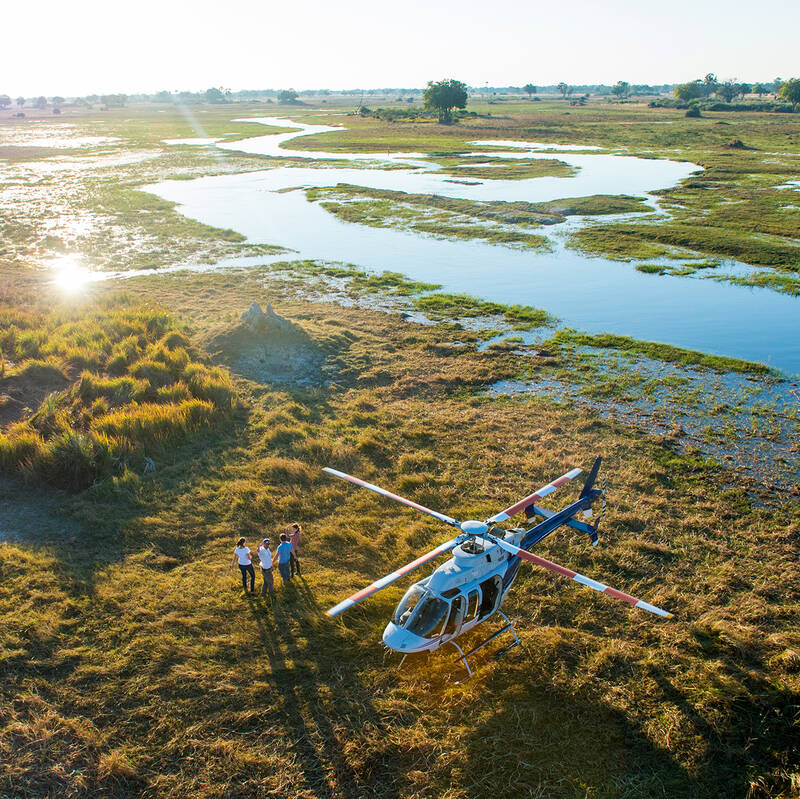
Helicopter Flight - Botswana
Various: from 30 minutes to half a day.
Low-flying, agile and offering superb views, helicopters are an ideal way to move around the Okavango Delta.You can use them instead of fixed-wing inter-lodge transfers or as an addition to other wildlife watching activities, and of course, helicopters can hover to allow that perfect pic, whereas fixed-wings can’t.
More about Helicopter FlightOther lodges in Kalahari's Salt Pans
Alternative places to stay in this same area.
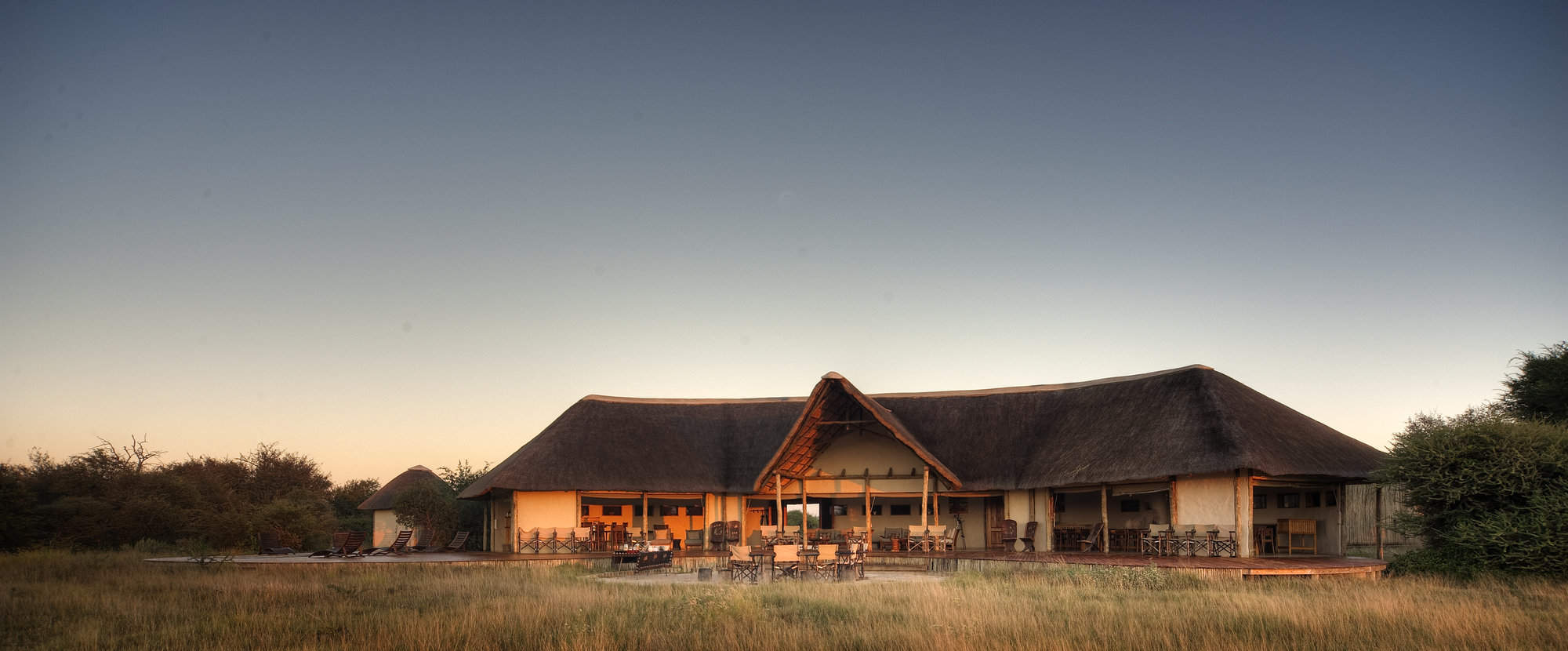
Nxai Pan Camp
Offering good summer game viewing and visits to Baines Baobabs, the comfortable Nxai Pan Camp is currently the only permanent camp in Nxai Pan National Park.
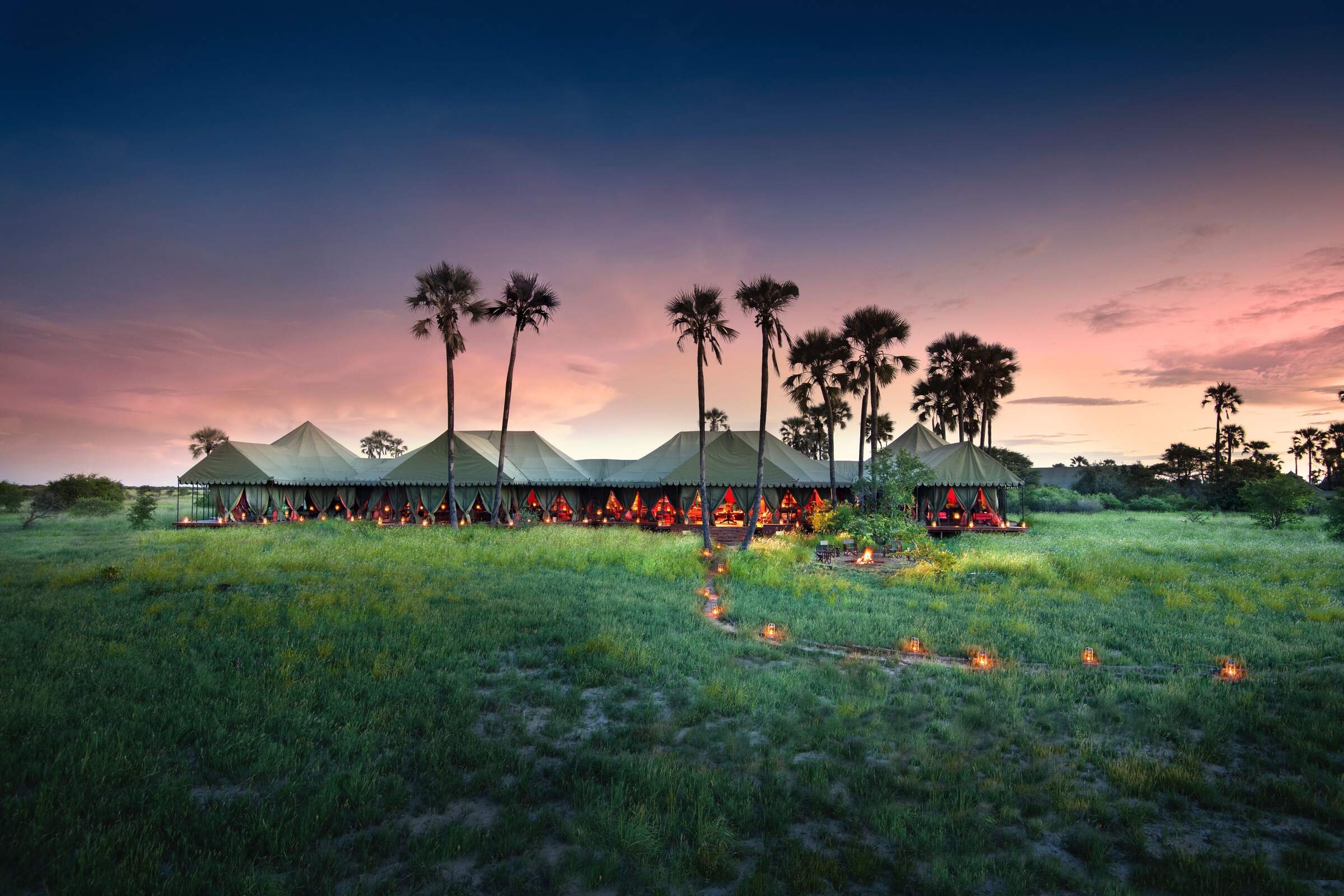
Jack's Camp
Jack's Camp was the original camp in the Makgadikgadi area, and many still consider it the best. Come for a unique and memorable experience, but not for prolific game viewing.
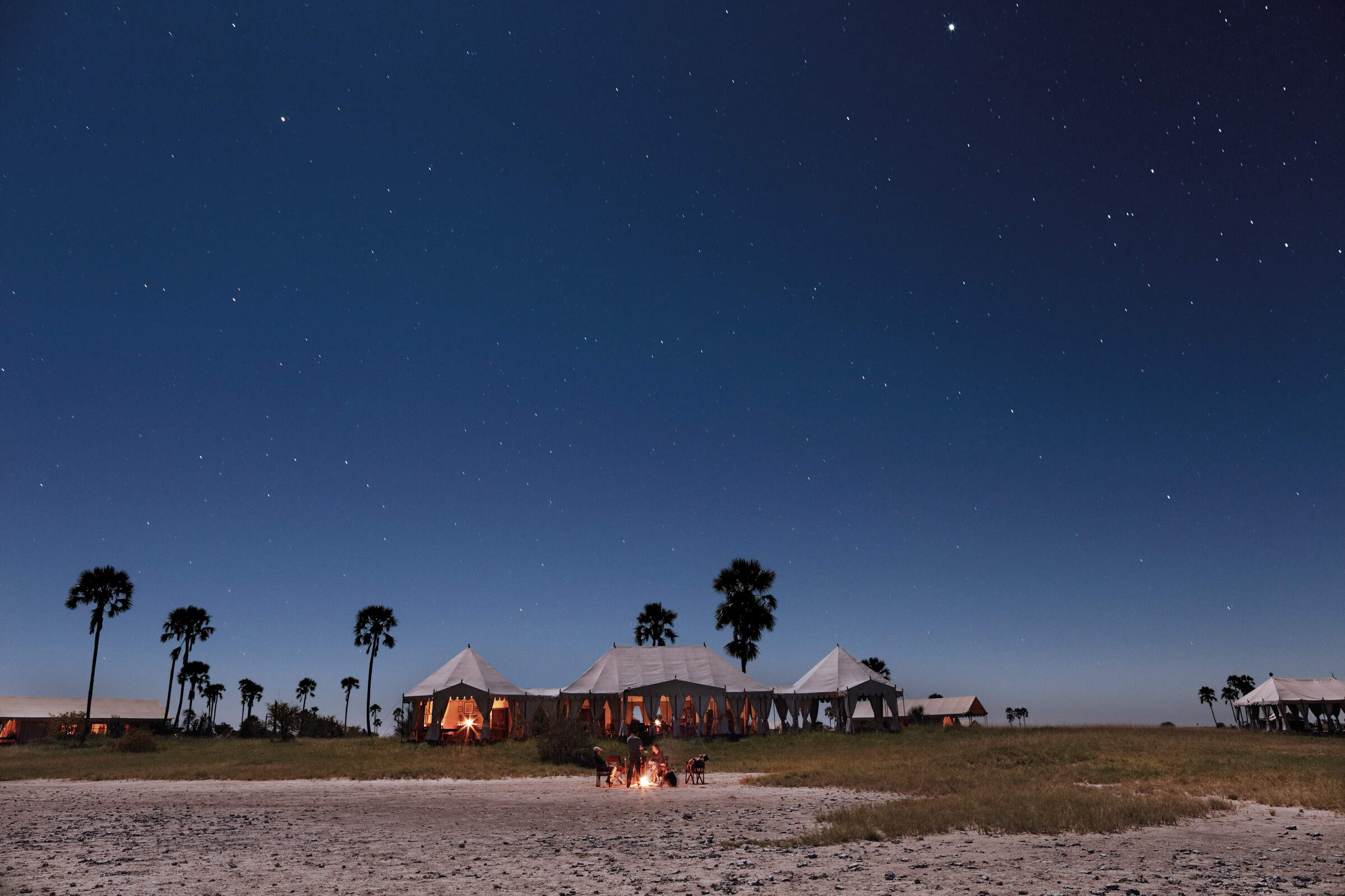
San Camp
The simple but stylish San Camp lies in a stunning location beside the Makgadikgadi Salt Pans, where highlights are quadbiking, meerkats, and Bushmen walks.
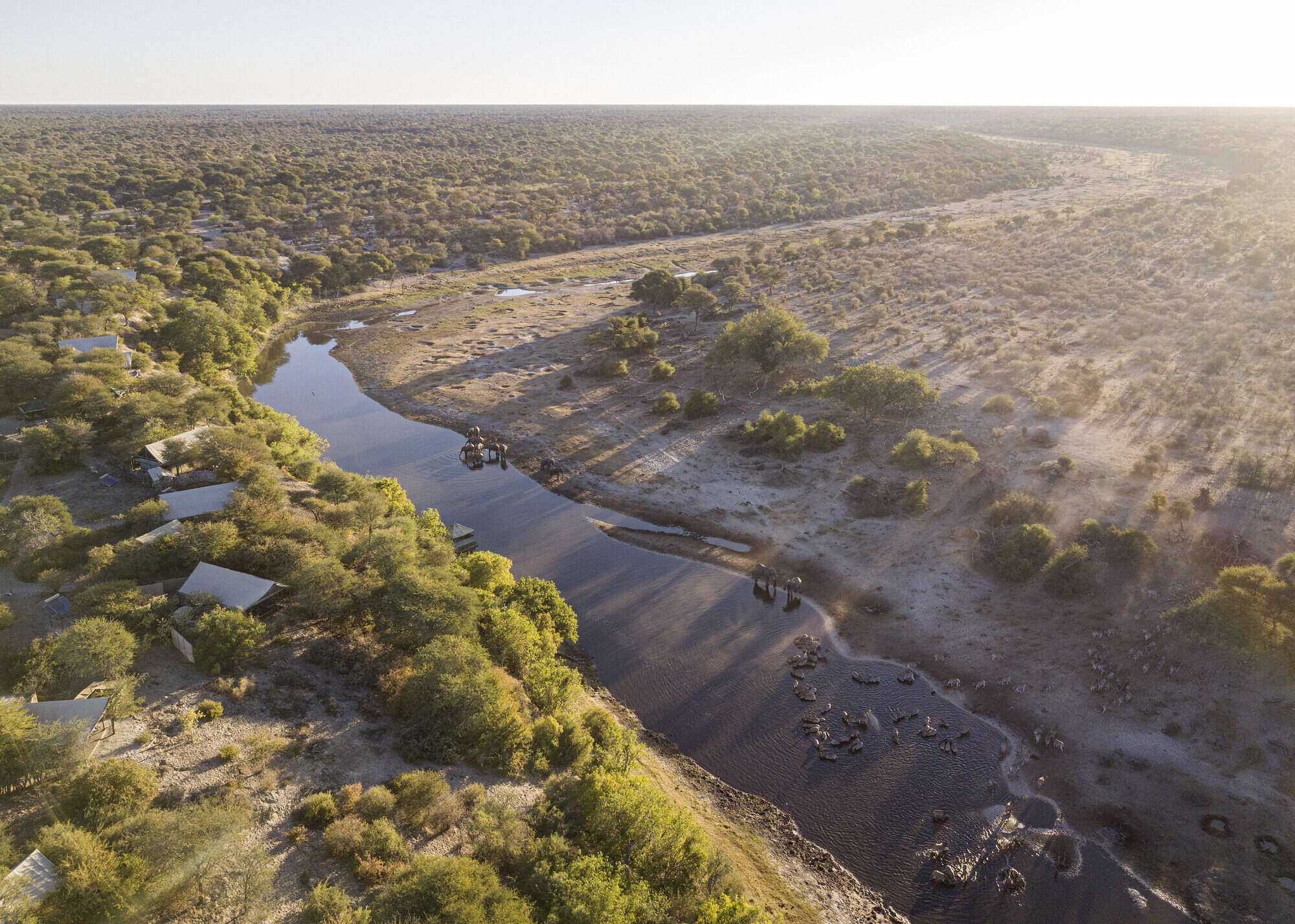
Meno A Kwena
Meno A Kwena Tented Camp is an old-style safari camp, run by an experienced Botswana expert. Overlooking the bed of the Boteti River, it's a great place to relax and watch wildlife at the camp's waterhole.
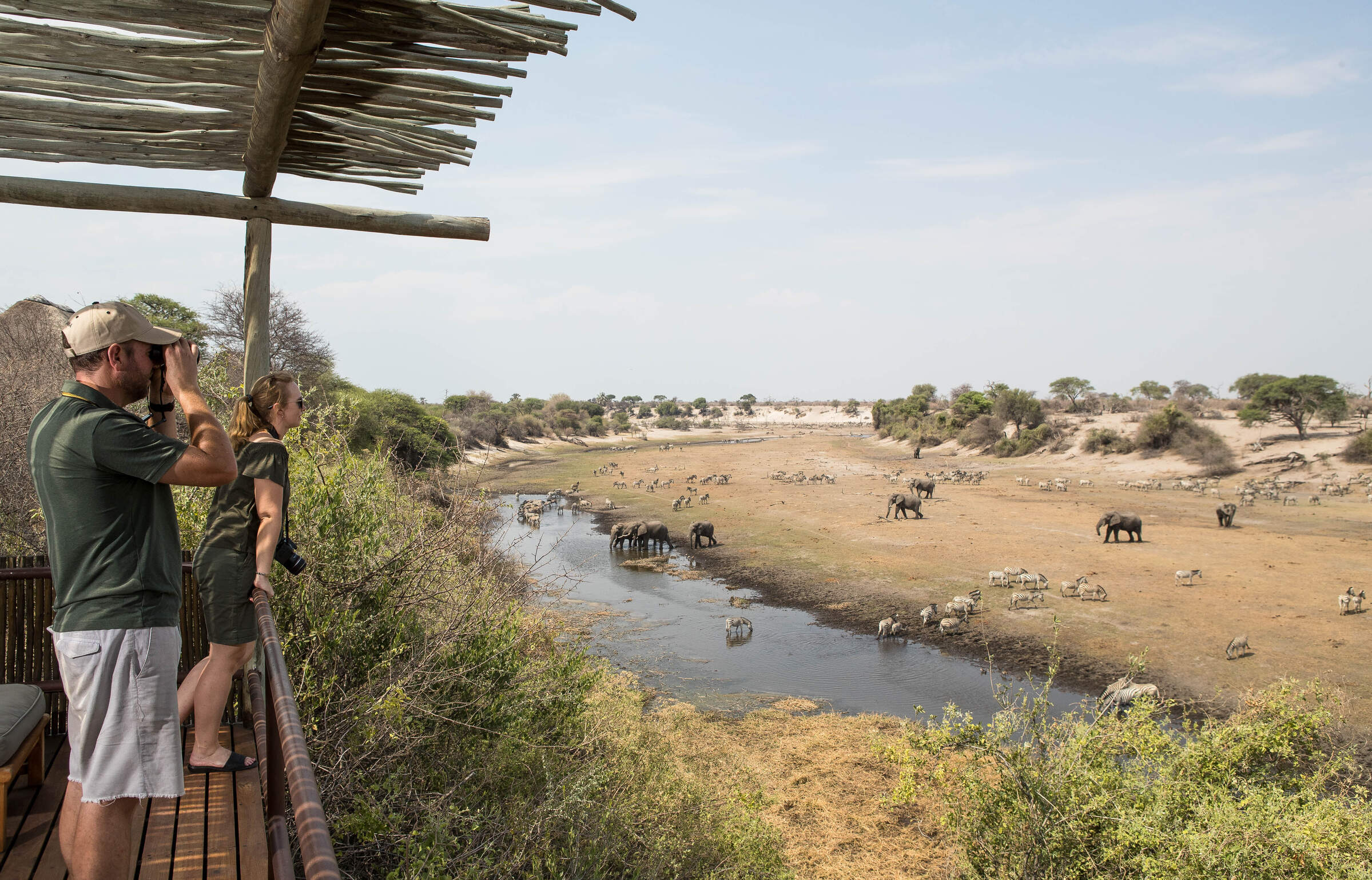
Leroo La Tau
From the western bank of the Boteti River, Leroo La Tau overlooks the Makgadikgadi Pans National Park, where game concentrations are highest from July to October.
When to go to Kalahari's Salt Pans
Our month by month guide: What it's like to visit Camp Kalahari in Kalahari's Salt Pans
Jan
Feb
Mar
Apr
May
Jun
Jul
Aug
Sep
Oct
Nov
Dec
Kalahari's Salt Pans in January
January is the peak of the rainy season, bringing short but intense downpours that flood the pans, transforming the landscape into a lush paradise. The Makgadikgadi and Nxai pans become vast grasslands, attracting large herds of zebra and wildebeest as part of their annual migration. The Boteti River swells, supporting a diversity of wildlife.
Birdwatching is exceptional, with migratory birds and flamingos breeding in Sua Pan. While game viewing can be challenging due to dispersed wildlife, patient observers can spot predators like lions and cheetahs taking advantage of newborn prey.
Low-season rates make this an attractive time for budget-conscious travellers.
- Salt pans flood, creating a dramatic transformation
- Zebra migration draws predators
- Flamingo breeding season in Sua Pan
- Exceptional birdwatching and photography opportunities
- Low visitor numbers, offering an exclusive experience
Our view
A good time to visit, with pros & cons
Weather in January
Kalahari's Salt Pans in February
February remains lush and vibrant, with the zebra migration in full swing across the pans. Nxai Pan National Park is particularly rewarding, as grasslands attract large herbivore herds and their predators. The famous Baines’ Baobabs stand starkly against the green backdrop, making for breathtaking photography.
With water sources abundant, birdwatching is at its peak, and flamingos continue to thrive in Sua Pan. The Boteti River remains active, drawing thirsty wildlife. However, thick vegetation can make spotting large animals more challenging.
Camps and lodges offer excellent availability and value during this period.
- Peak of the rainy season, pans fully flooded
- Zebra migration at its most dramatic
- Flamingos still abundant in Sua Pan
- Green season rates offer excellent value
- Lush landscapes provide an ideal setting for photography
Our view
A good time to visit, with pros & cons
Weather in February
Kalahari's Salt Pans in March
March is a transitional month: the main rains beginning to taper off but the Makgadikgadi and Nxai Pan landscapes remain lush and teeming with life. The zebra migration starts moving northward from Makgadikgadi and Nxai, but large herds are still present, making this a great time for game viewing.
If it’s accessible, this is a lovely time to visit Kubu Island, as the contrast between the granite outcrops and the surrounding greenery can be striking. Predators remain highly active, particularly around Nxai Pan and Kukome Island, where they hunt the last of the young antelope. Birdwatching is still rewarding, and as water begins to recede, quad biking opportunities start opening up in drier areas.
- Rains begin to taper off, but pans remain lush
- Final opportunity to witness the zebra migration
- Flamingos start to disperse from Sua Pan
- Good predator-prey interactions
- Shoulder season begins, with fewer tourists
Our view
A good time to visit, with pros & cons
Weather in March
Kalahari's Salt Pans in April
While occasional late rains may occur, April marks the end of the rainy season, with floodwaters receding and the landscape drying out. The Makgadikgadi Pans begin transitioning back to their iconic white salt flats as the water evaporates, creating striking contrasts for photography. This creates a unique landscape where wildlife is easier to spot against the increasingly barren backdrop.
Wildlife concentrates around the remaining waterholes in Nxai Pan, while the Boteti River can becomes a valuable lifeline for thirsty animals. Walks with San Bushmen and quad biking adventures on the salt pans become more accessible.
Night-time temperatures begin to drop, especially in the Central Kalahari area, making for comfortable evening game drives to spot nocturnal animals.
- Floodwaters recede, exposing salt flats
- Wildlife concentrates around remaining water
- Clear skies and mild temperatures perfect for game drives
- Baines’ Baobabs surrounded by seasonal water, ideal for photography
- Last month for good green season game viewing
Our view
A good time to visit, with pros & cons
Weather in April
Kalahari's Salt Pans in May
May is a popular month to visit the Kalahari Salt Pans region. The landscape has transformed, with the vast white expanses of Makgadikgadi Pans becoming more prominent. This creates surreal, otherworldly vistas perfect for photography. Wildlife concentrates around permanent water sources like the Boteti River, offering excellent game viewing opportunities. In Nxai Pan National Park, the famous Baines Baobabs stand out starkly against the drying landscape.
This is an ideal time for quad biking adventures across the salt pans. Cooler temperatures, especially in the mornings and evenings, lead to increased predator activity, and meerkat interactions are particularly rewarding, as they are active in the open plains. The skies remain crystal-clear, making for spectacular stargazing and astrophotography.
- Salt flats dry out, creating surreal landscapes
- Wildlife gathers at permanent water sources
- Perfect temperatures for safaris
- Quad biking becomes widely available
- Meerkat encounters highly rewarding
Our view
A very good time to visit
Weather in May
Kalahari's Salt Pans in June
June marks the official start of the dry season in the Kalahari Salt Pans region, bringing crisp, cool mornings and clear skies. The Makgadikgadi and Nxai pans are now vast, shimmering white expanses, offering incredible photographic opportunities. Wildlife viewing is excellent as animals congregate around the Boteti River.
Night-time temperatures can reach freezing, but daytime temperatures are pleasant. The clear, crisp air enhances visibility, making this a favourite time for serious photographers and one of the best months for stargazing. The atmosphere in June is at its clearest, allowing for spectacular views of the Milky Way. Meerkat encounters continue to be a highlight, with the animals more active in the cooler weather. The salt pans are now bone-dry, opening up thrilling quad biking excursions.
- Cold mornings, comfortable days for safaris
- Wildlife highly visible along the river and scarce waterholes
- Best time for quad biking across the salt pans
- Exceptional stargazing with crystal-clear skies
- Meerkats remain highly active and visible
Our view
Fantastic: the very best time to visit
Weather in June
Kalahari's Salt Pans in July
July offers excellent conditions for exploring the Kalahari Salt Pans. The Makgadikgadi Pans present a stark, lunar-like landscape, perfect for atmospheric photography. Wildlife viewing is superb, with animals concentrated around permanent water sources like the Boteti River. This is an excellent time to visit Nxai Pan National Park, where the famous Baines Baobabs stand out dramatically against the dry landscape.
The clear night skies offer phenomenal stargazing opportunities. Quad biking adventures across the salt pans are popular, providing a thrilling way to experience the vast, otherworldly terrain. Meerkat encounters continue to be a highlight, with these charismatic animals easily observable in the sparse vegetation. Guided walks with San Bushmen offer insights into traditional survival skills in this harsh environment.
- Peak dry season, best time for game viewing
- Ideal conditions for astrophotography
- Wildlife highly concentrated around water sources
- Quad biking across vast salt flats remains a highlight
- Bushmen cultural experiences highly recommended
Our view
Fantastic: the very best time to visit
Weather in July
Kalahari's Salt Pans in August
August marks the height of the dry season and is a popular time to visit the Kalahari Salt Pans, coinciding with northern hemisphere summer holidays. Mornings are cool and days are warm, making it perfect for a range of activities.
The Makgadikgadi and Nxai pans are at their driest, offering surreal, moon-like landscapes. Wildlife viewing is excellent, with animals congregating around the few remaining water sources, particularly along the Boteti River. This is a good time for exciting quad-biking adventures across the vast salt pans – though nights are cold.
For something more sedate, meerkat encounters continue to be a highlight, with clear visibility in the sparse vegetation, and evening stargazing is spectacular due to cloudless skies. The contrast between the white salt pans and the silhouettes of Baines Baobabs in Nxai Pan make for stunning photographic opportunities.
- Peak dry season, animals concentrated at the Boteti River
- Quad biking and guided walking safaris are at their best
- Clear night skies offer stunning stargazing conditions
- Wildlife sightings include elephants, lions, and plains game
- Meerkat encounters continue to be excellent
Our view
Fantastic: the very best time to visit
Weather in August
Kalahari's Salt Pans in September
September brings rising daytime temperatures to the Kalahari Salt Pans, while nights remain cool. The landscape is at its driest, with Makgadikgadi and Nxai pans offering vast, shimmering expanses. This creates ideal conditions for quad biking adventures and stunning photography, especially during the golden hours.
Wildlife activity remains high around permanent water sources, and the dry conditions make it easier to spot predators, particularly around the Boteti River and remaining waterholes. Nxai Pan National Park offers great opportunities to see desert-adapted species. This is a prime time for meerkat encounters, as these charismatic creatures are highly active. San Bushmen cultural experiences are particularly insightful at this time, as they demonstrate survival techniques in one of the driest landscapes of the year.
- Excellent predator viewing as dry conditions continue
- Elephants and large herbivores still frequent waterholes
- Sunsets are especially dramatic due to dust in the air
- Prime month for San Bushmen-guided experiences
- Stargazing and astrophotography remain outstanding
Our view
Fantastic: the very best time to visit
Weather in September
Kalahari's Salt Pans in October
October is one of the hottest and driest months in the Kalahari Salt Pans region, with daytime temperatures often exceeding 40°C/104°F. The Makgadikgadi and Nxai pans are vast, shimmering expanses, creating surreal, mirage-like vistas. This marks the last peak of wildlife concentration at the few remaining water sources before the first rains arrive. Predator-prey interactions along the Boteti River can become particularly dramatic.
Quad biking across the salt pans offers exhilarating adventures and unparalleled views of the lunar-like landscape. Meerkat encounters continue to be a highlight, with clear visibility in the sparse vegetation. As the month progresses, the chances of seeing dramatic dust storms increases, creating otherworldly scenes on the dry pans. The extreme conditions showcase the remarkable adaptations of desert wildlife. Stargazing is exceptional due to very clear skies.
- Hottest and driest month of the year
- Wildlife congregates along river and shrinking water sources
- Predator activity at its peak due to prey vulnerability
- Dramatic sunsets and striking landscape photography
- Quad biking and walking safaris continue to be a highlight
Our view
Fantastic: the very best time to visit
Weather in October
Kalahari's Salt Pans in November
November signals the start of the rainy season, with occasional early showers rejuvenating the arid landscape of the Makgadikgadi and Nxai pans. These rains are often short but heavy, creating spectacular storm clouds and lightning shows. The parched earth quickly absorbs the moisture, and the first flush of green begins to appear. Zebra herds begin returning to the salt pans, following the first shoots of fresh growth.
As water sources become more available, wildlife disperses slightly, but this is still an excellent time to visit. The mix of dry and wet conditions creates a striking contrast for photographers, and birdwatching improves as migratory species return.
- First signs of the wet season with sporadic rain showers
- Early zebra herds return to the pans
- Birdwatching season begins with new arrivals
- Beautiful contrasts between dry and green landscapes
- Shoulder season rates offer good value
Our view
A good time to visit, with pros & cons
Weather in November
Kalahari's Salt Pans in December
The rains in Botswana have now started, bringing some respite to the high temperatures. Game viewing becomes harder as wildlife is more dispersed but great sightings can still be had in the right areas such as Khwai and the Kwara and Mombo concessions.
Areas such as the Makgadikgadi Pans change completely with the salt pans becoming covered in a shallow layer of water attracting large numbers of breeding flamingos. Low-season rates at many camps are a draw.
- Temperatures starting to fall from the highs of October/November
- Very high chance of rain, usually large heavy storms for short periods
- Flamingos return to breed at the Makgadikgadi Pans
- Wildlife more dispersed, so game viewing more challenging
- Typically low-season rates in the camps
Our view
A good time to visit, with pros & cons
Weather in December

Looking for inspiration on where to travel next?
Visit our trip chooser to explore your options and find inspiration for your perfect African adventure
Inspire me